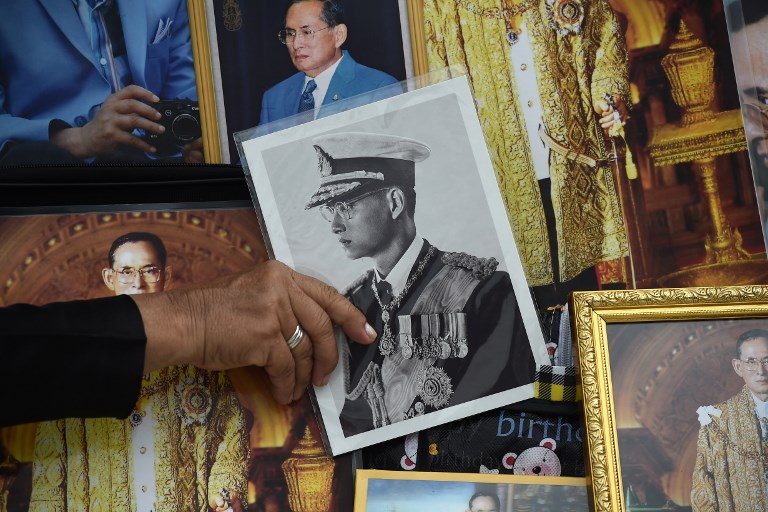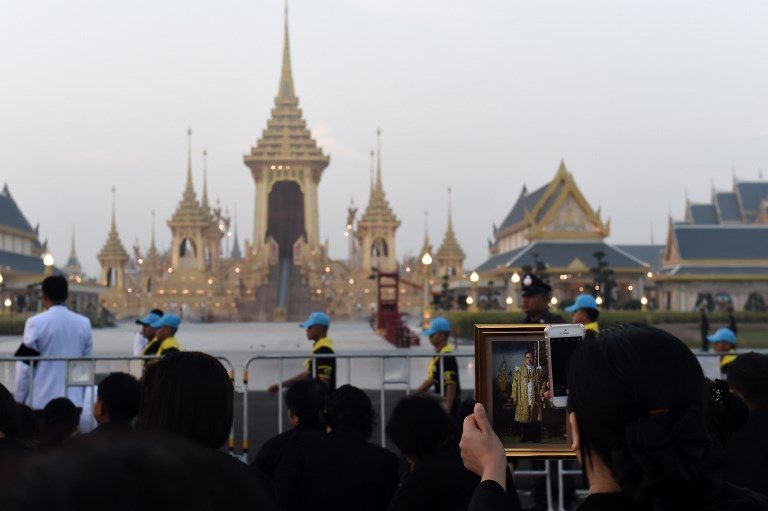SUMMARY
This is AI generated summarization, which may have errors. For context, always refer to the full article.

BANGKOK, Thailand – The spectacular send-off for Thailand’s late King Bhumibol Adulyadej began Thursday, October 26, with an elaborate collage of Buddhist rituals and palace protocol, ahead of his cremation at the gilded pyre erected in Bangkok’s historic heart.
The $90 million ceremony is a final act of devotion to the “father” of the nation, who died last year aged 88.
Here are a few things to know about the funeral of a king revered as a demi-god, and who reigned for 7 decades.
The site
At the heart of the cremation complex is a 50-meter (164-foot) high funeral pyre symbolizing Mount Meru, the allegorical center of the universe in Buddhist, Hindu and Jain cosmology.
The gold-painted structure is adorned with dozens of intricate sculptures of animals, deities and mythical creatures from Buddhist and Hindu lore.
Pride of place will go to sculptures of the late king’s beloved dogs.
Arranged symmetrically around the main tower are 8 smaller structures representing the mountains surrounding Meru.

The sprawling site, nearly a year in the making, is studded with references to the king’s welfare projects, including a small rice field and an irrigation wheel.
Bhumibol’s body is kept in a separate coffin to the symbolic Royal Urn, which will be carried up a ramp on a golden chariot to the pyre. Both the urn and coffin will be cremated, allowing his soul to pass into the afterlife according to Buddhist belief.
The ceremony
While somber, the funeral is also a celebration as the late king ascends to heaven, with music and traditional dancers a key part of the ceremony.
The funeral formally began on Wednesday, October 25, with a Thai Buddhist religious ritual led by Bhumibol’s only son King Maha Vajiralongkorn, known as Rama X. His father was Rama IX of the Chakri dynasty.
On Thursday the king joined monks in a remarkable ceremony, aided by palace officials shuffling on their knees to take the Royal Urn down for a procession from the Grand Palace to the cremation site.
A gun salute also rang out.
On its way to the cremation site it will pass tens of thousands of black-clad mourners who are expected to bow and prostrate where possible.
A bank of monks will lead Buddhist prayers throughout the day-long ritual.
As dusk falls, the king and other royals will lead the laying of sandalwood flowers at the urn.
The cremation itself will take place at 10 pm (1500 GMT) when Rama X will light the pyre.
Three days of ceremonies to remove royal relics from the ashes will follow. The ashes will be taken to the Grand Palace while the relics will be enshrined in two temples.
The guest list
The funeral procession will be headed by the king, Rama X, with his sister Princess Maha Chakri Sirindhorn leading the rest of the royal family.
It is not clear how much of a role Bhumibol’s wife Queen Sirikit will play, as she has been in ill health for years.
Power players from Thailand’s junta and the all-important privy council will also be prominent in the procession.
Royals and dignitaries from over 40 countries will attend the cremation, including Britain’s Prince Andrew, Japan’s Prince Akishino and Princess Akishino, Queen Maxima from the Netherlands, the King and Queen of Bhutan and US Secretary of Defense James Mattis.
Officials estimate that some 250,000 Thais will crush into the surrounding roads, while television will relay blanket coverage of the event.
The meticulously planned funeral comes with a long list of guidelines for attendees in a country where all things royal are tightly controlled.
Photographers are prohibited from taking direct shots of the king, while male journalists have been ordered to shave their beards and mustaches.
Tourists affected?
Roads across Bangkok’s historic center, including the Grand Palace, will be shut.
Tourists are not expected to wear black like most Thais have done since the king’s death in October 2016, but visitors have been asked to dress and behave “respectfully”.
Bangkok’s racy strips of go-go bars have closed for the cremation, while nightlife will be toned down throughout the funeral period.
Many businesses – including the ubiquitous 7/11 stores – will close for much of the cremation day. – Rappler.com
Add a comment
How does this make you feel?
There are no comments yet. Add your comment to start the conversation.